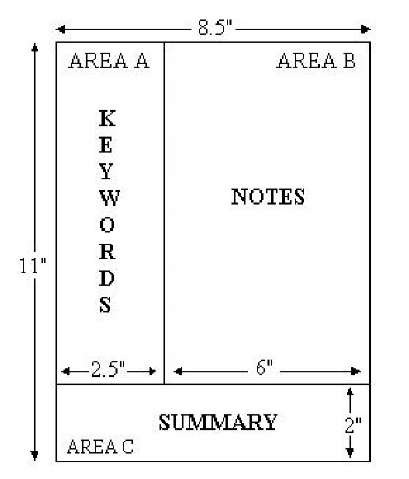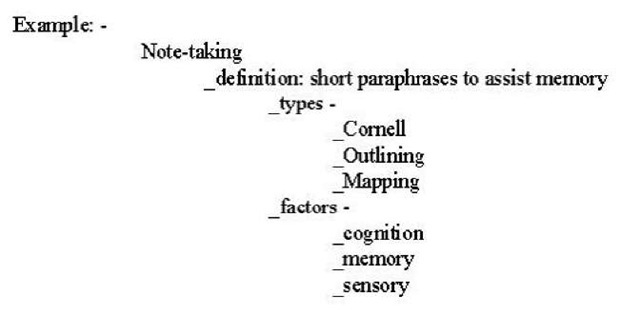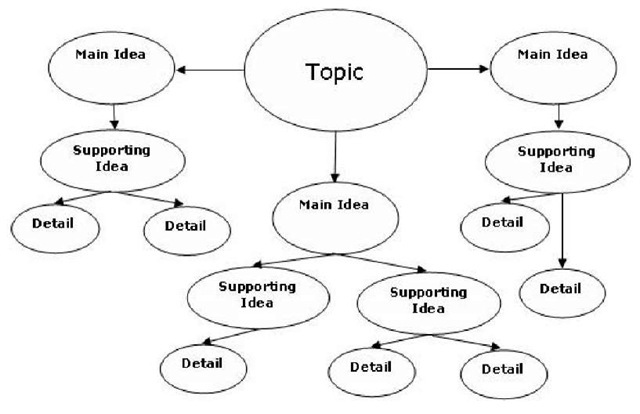INTRODUCTION
In all walks of life individuals are involved in a cumulative and incremental process of knowledge acquisition. This involves the accessing, processing and understanding of information which can be gained through many different forms. These include, deliberate means by picking up a topic or passive by listening to someone. The content of knowledge is translated by individuals and often recorded by the skill of note-taking, which differs in method from one person to another. This article presents an investigation into the techniques to take notes including the most popular Cornell method. A comparative analysis with the Outlining and Mapping methods are carried out stating strengths and weaknesses of each in terms of simplicity, usefulness and effectiveness. The processes of developing such skills are not easy or straightforward and performance is much influenced by cognition. Therefore, such associations regarding cognitive conceptions involve the exploration into note-taking processes encoding and storage, attention and concentration, memory and other stimuli factors such as multimedia.
The social changes within education from the traditional manner of study to electronic are being adapted by institutes. This change varies from computerising a sub-component of learning to simulating an entire lecture environment. This has enabled students to explore academia more conveniently however, is still arguable about its feasibility. The article discusses the underlying pedagogical principles, deriving instructions for the development of an e-learning environment. Furthermore, embarking on Tablet PC’s to replace the blackboard in combination with annotation applications is investigated. Semantic analysis into the paradigm shift in e-learning and knowledge management replacing classroom interaction presents its potential in the learning domain. The article concludes with ideas for the design and development of an electronic note-taking platform.
BACKGROUND
Over the years, research into note-taking has been carried out intensively. The paper aims to comparatively analyse the various note-taking techniques, providing an explanation into the effectiveness and simplicity. The relationship between cognition and note-taking is studied presenting a breakdown into the processes involved. Due to the vast amount of research into cognition its relevance is imperative. Although, great research within both areas has been undertaken to design an electronic note-taking tool, an analysis into existing applications has also been conducted, with Microsoft OneNote being the most favourable. This is an annotation application that has no predefined technique to record notes or annotations and saves handwriting as an image. Throughout the literature many authors work contributing to this study will be presented.
COMPARATIVE STUDY
This article presents an insight into note-taking, the various methods, cognitive psychology and the paradigm shift from traditional manner of study to electronic.
Note-Taking Techniques
Theoretically, note-taking is perceived as the transfer of information from one mind to the other. Today, the most popular note-taking technique is the Cornell note-taking method, also referred to as ‘Do-it-right-in-the-first-place’. This note-taking method was developed over 40 years ago by Professor Walter Pauk at the Cornell University (Pauk & Owens, 2005). The main purpose of developing this method was to assist students to organise their notes in a meaningful manner. This technique involves a systematic approach for arranging and condensing notes without the need to do multiple recopying. The method is simple and effective specifying three areas only. AreaA keywords, Area B notes-taking and Area C summary.
Area A is assigned to keywords or phrases, which are formed by students towards the end of the lecture. Over the years an alternative has been questions aiding recall over recognition. These cues are known to assist memory and pose as a reminder alongside helping to identify relationships, also referred as the Q-System (Pauk & Owens, 2005). Area B remains for the recording of notes during lecture. Here the student attempts to capture as much information as possible. Finally, Area C is left for the student to summarise the notes and reflect upon the main ideas of the lecture (Pauk & Owens, 2005).
The main advantage of this technique is its clear-cut and organised structure. This technique is also suitable for technical modules including Mathematics and Physics and non-technical modules such as English and History. During an engineering and applied sciences workshop, experiments involving 70 student participants revealed this note-taking method is straightforward (Anderson-Rowland, Aroz, Blaisdell, Cosgrove, Fussell, McCartney & Reyes, 1996). The authors Anderson-Rowland et al. (1996), state this method enables the organisation of notes, entails interaction and concentration therefore; a scheduled review can be conducted immediately highlighting keywords. Moreover, as the students can summarise content this facilitates learning by increasing understanding. Additionally, the strength of the technique is the ability to take notes instantaneously, saving time and effort due to its systematic structure.
Figure 1. The Cornell note-taking method
Figure 2. An example of the outlining note-taking method
In comparison, the Outlining method (see Figure 2) has a more spatial and meaningful layout, implicitly encoding conceptual relations. For example, indentation may imply grouping and proximity conceptual closeness (Ward & Tatsukawa, 2003).
The method consists of dashes or indentation and is not suitable for technical modules such as Mathematics or Physics. This technique requires indentation with spaces towards the right for specific facts. Relationships are represented through indentation. Note-takers are required to specify points in an organised format arranging a pattern and sequence built by space indentation. Important points are separated and kept furthest to the left, bringing in more specific points towards the right. Distance from the major point indicates the level of importance. The main advantage of this technique is the neatly organised structure allowing reviewing to be conducted without any difficulty. However, the Outlining method requires the student’s full concentration to achieve maximum organisation of notes. Consequently, the technique is not appropriate if the lecturer is going at a fast pace. The method has also been disapproved by Fox (1959) because of its confusing organisational structure. This is mainly due to the arrangement of numerals, capitalised letters and so forth.
In contrast to the Cornell and Outlining methods, the Mapping method (see Figure 3) is a graphical representation of the lecture content. Students are stimulated to visually determine links illustrating relationships between facts and concepts. Concept maps enable brainstorming, breakdown and representation of complex scenarios, identifying and providing solutions for flaws and summarising information. To enhance accuracy students must actively participate and initiate critical thinking. However, a drawback arguably, has been the structural organisation and relationship of nodes especially, questioning the hierarchical structure (Hibberd, Jones, & Morris, 2002). Alternative structures have been discussed including chain, spider maps and networks (Derbentseva & Safayeni, 2004).
E-Learning
E-learning, also known as distance education employs numerous technological devices. Today, educational institutes are well-known to deliver academia over the Internet. The growth of the internet is ever-increasing with great potential for not only learning material but also as a collaborative learning environment. The major difference between traditional learning and electronic learning is the mode of instruction by which information is communicated.
To have a successful e-learning system all sub-components and interrelated processes must be considered, because if one process fails then the entire system fails. Therefore, it is necessary to derive a series of pedagogical principles. Underlying pedagogical principles include considering the user’s behaviour towards the system, as it is an isolated activity resulting in user’s becoming frustrated. As the internet has a great deal of knowledge it can be presented in a bias manner providing users with partial information. Considerations for the environment and the user actions to be performed to achieve a specific goal must be outlined. Moreover, user’s interpersonal skills including their attitudes, perceptions and behaviour are central to influencing the effectiveness of the system. It has been learned e-learning reduces teaching time, increase proficiency and improves retention. However, this is not always correct, as in one study, results of online lecture notes showed students performed weaker (Barnett, 2003). From student’s perspective, they continuously pursue communication and support to influence their learning. They also welcome constructive feedback (Mason, 2001).
The major challenges faced by the e-learning society are the culture clash and lack of motivation towards an electronic learning environment. People are just not prepared to accept the change. A major factor determining successful outcomes of such systems is the level of interactivity provided. Other significant pedagogical principles include the level of control users feel, in comparison to traditional manner of learning where the lecturer has full control over the lecture environment. Moreover, the development of a suitable interface is necessary considering usability factors such as efficiency, error rates, memoryability, learnability and subject satisfaction. As a tutor, the planning behind the course structure is important, paying close attention towards the structure of content. Tutors must ensure students receive feedback in an appropriate time maintaining time management. Overall, before considering the design and development of an e-learn-ing environment the main factors to consider include the learners, content, technology, teaching techniques, and so forth (Hamid, 2002).
Technologies associated with e-learning have increased usage of bandwidth and internet access. Presently, there are two key technologies used to de liver e-learning, ‘scheduled delivery platforms’ and ‘on-demand delivery platforms’. Scheduled delivery platforms include multicasts, virtual libraries and remote laboratories, yet the constraints of these include time and area restraints. To further improve these systems, on-demand delivery platforms provide 24 hour support maintaining flexibility of learning (Hamilton, Richards & Sharp, 2001).
Figure 3. Example of the mapping method
The efficacy of electronic notes in one particular study showed improvement in students understanding of lecture content, resulting in an overwhelming 96% users feeling e-notes are an effective tool (Wirth, 2003). Users are able to annotate, collaborate and discuss subject content. This increases learning efficiency by allowing the user to engage into the text, improving their comprehension and supporting memorisation. Recall of specific details is also enhanced (Wolfe, 2000). Numerous annotation applications have been introduced including Microsoft Word and OneNote primarily concerned with annotation. SharePoint™ allows manipulation editing and annotation simultaneously as well as Re:Mark™. Microsoft OneNote as an annotation tool is more popular however, the end-user is required to possess a copy of it in order to use it, unlike Microsoft Journal which can be exported as a .mhtml file (Cicchino, 2003). Additionally, handwriting is translated as an image rather then text that can be explored (McCall, 2005). The benefits include ability to record a lecture and annotate, referencing to specific points within the recording. These can then be used later (McCall, 2005).
Tablet PC’s are being used to replace the blackboard presenting course material through a data projector. Many academic institutes are adopting these as a teaching tool (Clark, 2004) or are providing students with them as teaching devices (Lowe, 2004). The major strength of a Tablet PC is its interactivity between face-to-face instructions (Cicchino, 2003). However, a study that provided students with pen-based computers for the purpose of taking notes presented the project as unsuccessful because the devices where unsuitable in terms of performance, poor resolution, and network factors (Truong, Abowd & Brotherton, 1999).
Cognition
The most common mode of instruction in higher education is lectures where attending students take notes based on the lecture content (Tran & Lawson, 2001). In class, students spend approximately 80% of their time listening to the lecture (Armbruster, 2000) and the reason students take notes is because of their usefulness towards learning and due to social pressures (Tran & Lawson, 2001). Students vary their note-taking technique according to personal experience, existing knowledge, and appropriateness to the lecture format. Problems within the classroom are caused due to student’s inability to copy information presented by the lecturer (Komagata, Ohira, Kurakawa & Nakakoji, 2001). Whilst engaging in reading or listening metacognition, the human mind has a tendency to wander off thinking about thoughts other than what is being taught or learnt.
During the learning process, effects on learning occur during the encoding and storage processes. The encoding stage is when students attend lecture and record lecture notes whereas, the storage phase is when students review their notes. To achieve optimum performance, both the encoding and storage processes should be combined. The reviewing of lecture notes is significantly important especially when conducted in close proximity to an exam. Additionally, students should also monitor their individual progress and understanding of information before an exam. This can be achieved by carrying out self-testing. This method can also be encouraged by the lecturer providing relevant material for example, past exam papers.
Students with greater memory-ability benefit from note-taking with studies finding students with lower memory-ability record a lower number of words and complete ideas (Kiewra & Benton, 1988). This is due to variations within the working memory as information is stored and manipulated there. Therefore, the ability of note-takers to pick out relevant details, maintain knowledge and combine new knowledge to existing knowledge are essential factors. Human memory can be broken down into three types; Short-term; long-term and sensory memory. Short-term memory allows information to be stored for a short period before being forgotten or transferred to long-term memory. Long-term memory endures information for a longer period into the memory circuit. The brain circuit includes the cerebral cortex and hippocampus. Finally, the sensory memory is the initial storage of information lasting an instant, consisting of visual and auditory memories. Information here is typically gathered through the sight and sound senses.
The incorporation of multimedia within education can enhance the learning experience in a number of ways. Significant sensory aids can be provided, interactivity can be increased and a richer learning experience can be initiated. The presentation of learning material and the manner in which content is captured is important. This is because if during a lecture organisational cues are explicitly defined the organisational process is guided (Titsworth & Kiewra, 2004). Moreover, the use of non-speech audio amalgamated within user-interfaces is becoming increasingly popular. If complimented with visual output it can increase the amount of information communicated to the user. A typical student captures 29% visual, 34% auditory and 37% haptic metaphors (Dryden & Vos, 1999). Sound provides greater flexibility as it can be heard 360° without having to concentrate; this is in comparison to visual output where the retina subtends an angle of 2° around the point of fixation. Consequently sound is a superb way of capturing user attention. Furthermore, graphical displays including icons, menu graphics and so forth can be used as an iconic representation of a user’s action.
FUTURE TRENDS
The increase in electronic learning tools and e-learning environments within education are ever-increasing and so the necessity to derive a flexible learning structure with interactivity is paramount. Studies relating to the computerisation of note-taking tools are not so prominent. Nonetheless, the comparative study does demonstrate the effectiveness of using a note-taking method, especially the Cornell method which is most popular. Additionally, a popularity trend amongst multi-modality including audio sounds in particular earcons have shown, there is potential to combine these within learning to benefit from the experience and enhance interactivity. Moreover, in-depth research into psychological learning parameters especially encoding and storage processes have demonstrated the need to combine the two together to optimise performance. The introduction of annotation applications has instigated a trend towards electronic learning platforms although, usability issues to personalise the student experience must be further studied.
CONCLUSION
This article provides a comparative study into note-taking techniques, the processes involved and the effects of cognition upon learning. The literature suggests current electronic learning tools amalgamate many learning functions, including lecture notes, handouts, discussions and so forth into one application. Integration issues including cost factors, hardware deficiencies and malfunctions in subcomponents leading to system failures are major issues brought to light. Moreover, the primary focus into the skill and technique of note-taking have been analysed with no such technique provided as an electronic tool. Therefore, the design and development of a sub-component of e-learning, a note-taking tool is being considered based upon the studied research. The Cornell note-taking method has been arguably more effective with regards to simplicity, ability to deploy it within any subject area and appropriateness. Therefore future work will consider the influences of multimedia upon this technique, including earcons, visual structure, layout, and possibly the incorporation of speech.
KEY TERMS
Annotation: The activity of briefly describing or explaining information. It can also involve summarising or evaluating content.
Cognitive Psychology: A study into cognition such as mental processes describing human behaviour, understanding perceptions, examining memory, attention span, concentration, and forgetfulness. The purpose of understanding humans and the way they mentally function.
Information Processing: The ability to capture, store and manipulate information. This consists of two main processes; encoding and storage. Students record notes during the encoding stage and conduct reviewing thereafter, in the storage phase.
Metacognition: The ability and skills of learners to be aware of and monitor their learning processes.
Multimodality: An electronic system that enhances interactivity by amalgamating audio, visual and speech metaphors.
Pedagogical Principles: Key issues to instruct the design and development of an electronic learning environment.
Platform: Computer framework allowing software to run for a specific purpose.
Traditional Manner of Study: Typically a classroom environment with the tutor writing content on a blackboard and students using pen and paper to record the content as their own notes. The tutor dominates the classroom environment unlike in electronic learning where, the user has a sense of control due to flexibility in learning.



